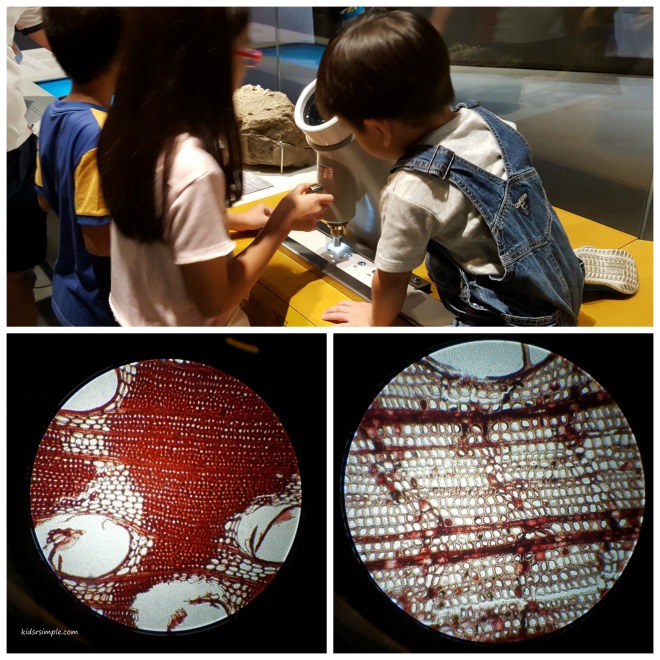
This is a place which I had been wanting to go to since its first opening last year. You have to book through Sistic ticketing for entry to the museum. This is to ensure a pleasant visit. You wouldn’t want to risk shoving or being shoved off at every exhibit. And that reminds me of the time when I visited The Palace Museum (Forbidden City) in Beijing during Summer holidays. It was a pain just to catch a glimpse of the Emperor’s throne when I was pushed and elbowed by grandmas and kids. Thankfully this museum is nothing like that.

Lee Kong Chian Natural History Museum (LKCNHM) is built for public education and research in biodiversity. It is a museum that maintains and grows a natural heritage knowledge base that focuses on its huge collection of historical and research specimens (Source: LKCNHM website).
Let’s take a look at some of the exhibits that we like.
PLANTS
We saw this in Gardens by the Bay. The famous flower known for its super stink smell – Rafflesia, discovered by known other than Sir Stamford Raffles during his expedition in 1818. I have never had a chance to smell this though.

There are a number of such posters teaching biodiversity in the museum. Here are a few of them which I feel are good knowledge for adults and students alike.



Can you spot human existence on this chart? Imagine the earth had been around for so many millions of years ago.
Below is a chart of the life cycle of fungi. A good chart to fit into the primary school science syllabus which my kids are learning on this topic.

Look at these ear phones for audio playing of some information and interviews.

Slice of the Changi Tree – The Changi place in Singapore is named after this tree.
Viewing the microscope on tree bark cells

DINOSAUR ZONE
These 3 dinosaurs are certainly the highlight of the museum. They were able to make it into the LKCNHM thanks to lots of donation from generous donors and donors from all walks of life. Their skeletons are found nearly complete and even though experts are undecided about their genus and species, they are certain that they belong to the Diplodocidae family.

This must be the newest addition to the museum – The Singapore Sperm Whale. It was found dead off Jurong Island with a big gash on her back, suspected to have been caused by a propeller. Immediately after it was found, an emergency salvage operation took place. In just 70 days, the carcass was defleshed and the oily skeleton degreased and prepared for display.

A closer look showed that whales being mammals, have finger skeletons under the fins.

MAMMAL ZONE
Look at these enthralling specimens! They looked so lifelike that Missy 11 and Master 9 imagined that they come alive in the middle of the night!


Tusk of Narwhal – “Unicorn of the Sea”

Do you know that in the past, there were different human species that inhabited the world? All humans belong to the Homo sapiens Linnaeus. Anthropologists have suggested that Homo sapiens have relatively larger brains than other early humans, possess an unequalled capacity to plan, communicate and alter the environment to suit their needs. These are probably the reasons that they threaten the survival of many other species.

The Human and Orangutan skeletons

Birds

MARINE CYCLES
The different types of Sea Urchins


ANIMAL ARCHITECTURE
Life Cycle of the Frog


Green Sawfish and Jaws of Longfin Mako Shark

Heritage Gallery
On the second level, we have some historical specimens that were moved and housed in several locations. From the National Museum in the 1970s to the University of Singapore and to the NUS Department of Zoology and now in the Lee Kong Chian Natural History Museum.

We spent slightly more than 2 hours in the museum and spent a great amount of time on first level. I would have taken more time though if I had the luxury to slowly read through the information in front of the specimens and displays. This museum is certainly worth our time to bring our kids here for a lesson on biodiversity. In fact, I am very proud that Singapore has this museum to teach young and old alike on history and science.
If you are heading towards the museum, do remember to book your tickets through sistic.
More information on Lee Kong Chian Natural History Museum:
Opening hours – Tues to Sun & Public Holiday – 10am to 7pm (Closed on Mondays except Public Holidays)
Session timings – 10am, 1pm, 4pm (3 slots for visiting)
Entrance Fees – click here to find out the latest promotions and fees. NUS staff and students enter for free.
Address – Faculty of Science, National University of Singapore, 2 Conservatory Drive, Singapore 117377
Telephone – 65-6601-3333
Facebook – click here

Very interesting. I will definitely bring my kids there since the boy have a love for animals and dinosaurs. Thanks for sharing!
You should! Best to slowly read and explain to them. Kids at this age will not be understand fully, but the exhibits should interest them more